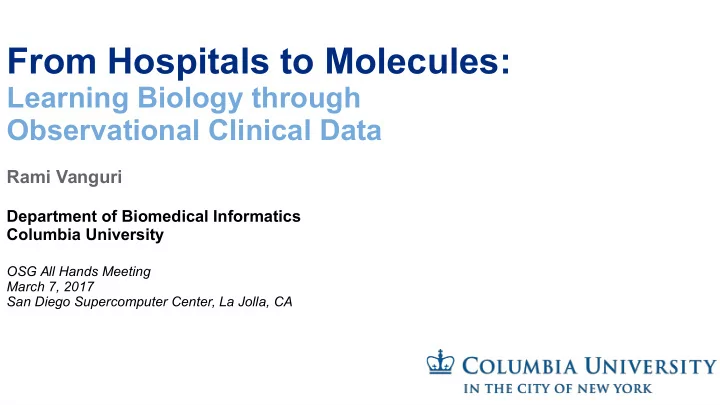

From Hospitals to Molecules: Learning Biology through Observational Clinical Data Rami Vanguri Department of Biomedical Informatics Columbia University OSG All Hands Meeting March 7, 2017 San Diego Supercomputer Center, La Jolla, CA
My Background ● Undergraduate at UCSD and worked for fkw on CDF ● PhD at Penn on ATLAS ● Currently Postdoctoral Research Scientist at Columbia University working for Nicholas Tatonetti ● The result is that I know something about computing, next to nothing about biology
What is biomedical informatics? “Biomedical informatics is the study of information and computation in ● biology and health. Healthcare research is experiencing a deluge of new data — such as a patient’s genome sequence, electronic medical records, or the complete genomic and metabolic characterization of a tumor — which necessitate the development of novel methods to interrogate, integrate, analyze, and organize this diverse information.” Design and implement novel quantitative and computational methods to ● solve wide array of problems in biology and medicine
What does our lab do? ● Translational bioinformatics: integrate medical observations with systems and chemical biology models to further biological understanding ● “Bench to bedside”
Why big computing? ● Computational jobs are becoming larger – Used to be able to use 2 servers with ~100 CPUs – Reached limitations, went to AWS and OSG ● Deep learning extremely powerful tool, efficient via GPU
datasets are heterogenous! raw data analysis “reconstruction” + structured unstructured
Clinical Data Challenges ● Missingness, incomplete, messy ● Heterogeneous data types (genetics, EHR, protein networks) ● Protected Health Information – HIPAA concerns ● Electronic health records stored in SQL tables
Clinical Data Analysis Example: h 2 ● Heritability estimates the amount of variation in a trait is due to genetics (vs environment), known as h 2 – Estimating heritability usually involves in-depth dedicated studies (twins, mice, etc) – Limited sample size
By using emergency contact information in Columbia University Medical Center electronic health records, we can infer 4.7M familial relationships and use them to estimate various disease heritabilities.
Inferred Relationships
Calculating Heritability ● Traits are assigned in electronic health records via insurance billing codes (ICD-9) ● Observational heritability: estimate of h 2 where the phenotypes are from observational data – Access to traits not able to evaluate with traditional studies (such as neurological)
Specifics on Computing Needs ● Small data input (list of individuals with/without trait), small data output (h 2 ), long processing time ● Thousands of jobs – time for each job (trait) depends on number of affected individuals ● Difficult to know runtime a priori
Next project (nSIDES) ● Mine public FDA dataset for statistically significant drug effects ● Deep learning is used to to calculate bias space in FDA reports – We have a GPU test bed for this (Tesla K40) – Not sustainable for the number of models we need to generate
Specifics on Computing Needs ● GPU jobs, take hours each – ~4500 initial jobs to calculate single drug effects – Many more to calculate drug interactions ● AWS mechanism to connect instances will be used to supplement OSG resources
Biomedical Translator NIH funded program to accelerate biomedical translation for the research community. Existing biomedical data spanning clinical, genetic and fundamental biology will be integrated to form disease classification that can be targeted by various preventative and therapeutic interventions.
Biomedical Translator ● Spans 11 universities including Columbia and UCSD (Trey Ideker) ● We will use nSIDES to form prototype for translator – DeepLink
DeepLink
DeepLink
Future Projects (Clinical Notes) ● Use deep learning techniques to analyze clinical notes – Classify undiagnosed patients – Discover distinct disease subtypes – Predict patient disease course ● We predict that GPUs will be the primary computing need
Future Prospects: Genomics Medicine ● Leverage clinical note analysis to recruit patients for sequencing ● Discover causal genetic variants ● Uncover mechanism Genetic analysis and deep learning require extensive computing resources
Summary ● As machine learning has advanced, grid computing has become necessary to efficiently analyze large amounts of clinical data ● Direct implications for generating biological hypotheses, leading to better understanding of drug interactions and disease
Acknowledgements tatonettilab.org r.vanguri@columbia.edu Lab Members Yun Hao Nicholas Tatonetti Joseph Romano Kayla Quinnies Funding Phyllis Thangaraj Theresa Kolek NIH NIGMS R01GM107145 Alexandre Yahi Alexandra Jacunski NIH NCATS OT3TR002027 Fernanda Polubriaginof Tal Lorberbaum Herbert Irving Fellowship Victor Nwankwo Mary Boland Tatonetti Lab at Columbia University
Recommend
More recommend